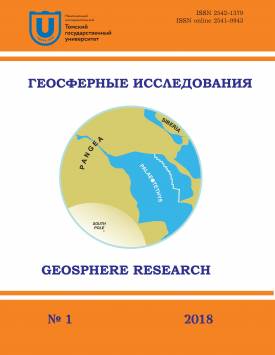Some data of the new Campanian-Maastrichtian Polymorphinidae species (Foraminifera) of the Western Siberia
Family Polymorphinidae Orbigny, 1846 is one of the impotant group of the order Polymorphinida Wedekind, 1937, of subclass La-genata Maslakova, 1990 class Foraminifera Orbigny, 1826. The test of shell Polymorphinidae is secreted calcareous and differ their intrinsity constraction. Morphological criterion have leid in the base to creation of different genera. In this paper auther have stadied the species of the several genera. The morphological criterion is a cardinal one taking into account the composition and microstructure of the test wall. The studies of the morphological peculiarities of the Polymorphinidae tests are based on different features elaborated mainly by the auther. In subfamily Polymorphininae Brady, 1881 the first time two subspecies of species Globulina amygdaloides Reuss, 1851 have been described: G. amygdaloides variabilis Kseneva subsp. nov. and G. amygdaloides sibirica Kseneva subsp. nov. In the other Globulina gibba (Orbigny) species has been described one new subspecies: G. gibba tumidiuscula Kseneva subsp. nov. The Si-phoglobulina ovoiformis acutata Kseneva subsp. nov. has been described in this paper. In the second subfamily Ramulininae Brady, 1884 auther was stadied one new species - Ramulina globosa Kseneva sp. nov. These Polymorphinidae are found from the Campanian -Maastrichtian deposits of Gankinskaya suite the same name of Horizon in Western Siberia. This suite consist of terrigenius alevrolites with including of carboniferous material differ from the other tarrigenius facies in Mesozoic section. Such taxons of foraminifera from section of West Siberian province have similar genera in East European province of Boreal-Atlantic Realm. The descriptions of the Polymorphidae taxa perfomed by the author relied on five criteria such as morphological, geochronological, philogenetic, palaegeographical, palaebiogeographical. The species and subspecies were analazed by means of the electronic microscopy in the Biology and Biophysics Research Institute of TSU. The factors of the habitat and geographical isolation play a great role in the Polymorphidae systematics. This naturally suggests that the palaegeographical criterion must be taken into consideration. While studying the new species and subspecies of the established family, the discrepancy with Kuzina's data was revealed not only in age determination but also in the palaegeographical occurrence and location of Polymorphinidae. The subspecies Siphoglobulina ovoiformis (Kuzina) subspecies acutata (Kseneva) subsp. nov. differ from a standard species (Kuzina, 1979) morphologically. Kseneva's subspecies is represented by an acerated initial loculum, bending oval bulding shapes of the subsequent loculum and other features. In paper two paleontological tables with describing taxons. The typical taxons are kept in micropaleontological laboratory of Tomsk State University.
Keywords
фораминиферы, полиморфиниды, кампан, маастрихт, Западная Сибирь, foraminifera, Polymorphinidae, Campanian-Maastrichtian, Western SiberiaAuthors
| Name | Organization | |
| Kseneva Tatyana G. | Tomsk State University | kseneva@ggf.tsu.ru |
References

Some data of the new Campanian-Maastrichtian Polymorphinidae species (Foraminifera) of the Western Siberia | Geosphere Research. 2018. № 1. DOI: 10.17223/25421379/6/4
